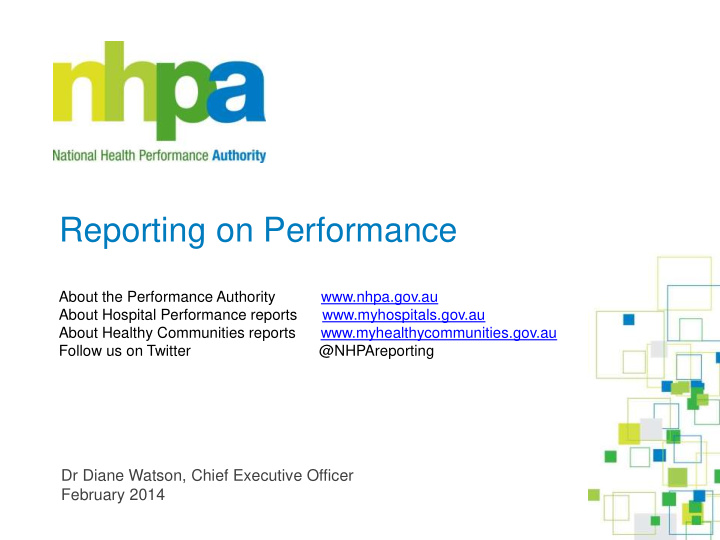



Reporting on Performance About the Performance Authority www.nhpa.gov.au About Hospital Performance reports www.myhospitals.gov.au About Healthy Communities reports www.myhealthycommunities.gov.au Follow us on Twitter @NHPAreporting Dr Diane Watson, Chief Executive Officer February 2014
National Health Reform Act To monitor, and report on, the performance of the following: • Local hospital networks • Public hospitals • Private hospitals • Primary health care organisations • Other bodies or organisations that provide health care services.
Our Mission Monitor, and report on, the comparable performance of • S ubtitle health care organisations to stimulate and inform improvement in the Australian health system, increase transparency and accountability and inform consumers. P repared DD/MM/YYY
Our websites www.nhpa.gov.au www.myhospitals.gov.au www.myhealthycommunities.gov.au
Healthy Communities reports
COAG indicators for Medicare Locals (examples) • Effectiveness – Safety and quality • Selected potentially avoidable hospitalisations • Effectiveness – Patient experience • Measure of patient experience • Equity and effectiveness – Access • Access to services by type of service compared to need • GP type service use • Vaccination rates for children • Number of women with at least one antenatal visit in the first trimester • Health outcome context • Prevalence of diabetes S ubtitle • Infant/young child mortality rate P repared DD/MM/YYY
Next slide
Public reporting as a catalyst for change Healthy Communities: Immunisation rates for children in 2011 – 12 • Almost 77,000 Australian children not fully immunised • Results were broken down to more than 300 local areas and in some cases individual postcodes • More than 700 media stories over 30 days. Audience reach over 29 million and still cited throughout the year • More than 60,000 people looked up their local rate on the post code interactive tool on www.nhpa.gov.au • NSW Cabinet backed legislation to amend the Public Health Act - f rom 1 January 2014 NSW children now required by law to show immunisation records to childcare providers at enrolment Launched 11 April 2013
Public reporting as a catalyst for change Healthy Communities: Overweight, obesity and tobacco smoking rates in 2011 – 12 • 80% of adults overweight or obese • Lowest rate = 49% in a wealthy urban area. Still very high! • % of adults who smoke daily almost four times higher in some areas • Front page coverage in the Sydney Morning Herald on launch (during the October 2013 bushfire crisis) • Almost 300 media articles within 30 days. Audience reach over 5.3 million. Stories still appearing … Launched 24 October 2013
Public reporting as a catalyst for change Healthy Communities: Avoidable deaths and life expectancies in 2009 – 2011 • 33,000 deaths potentially avoidable • These accounted for more than 60% of deaths in persons 75 years and older • Life expectancy at birth up to 8.5 years from one community to another • Quality and focused media coverage with 120 media articles within 30 days, audience reach almost 2 million • High stakeholder interest and supporting media releases issued Launched 12 December 2013
MyHealthyCommunities.gov.au Health status and outcomes • Ratings of health • Chronic conditions Prevention • Immunisation rates: 1, 2 and 5 year • Immunisation rates among Aboriginal children • Overweight, obesity, smoking Experiences with care • Wait times for GPs • Wait times for specialists • Cost barriers to GP • Cost barriers to dentists • Cost barriers to specialists Use of services • Visits to dentists • Visits to GPs • Visits to medical specialists Expenditures on services • GP services
Hospital Performance reports
COAG indicators for Hospitals (examples) • Effectiveness – Safety and quality • Hospital mortality • Unplanned readmissions • Effectiveness – Patient experience • Measure of patient experience • Equity and effectiveness – Access • Access to services by type of service compared to need • Cancer care pathway – waiting times for cancer care • Elective surgery waiting times by urgency category • Efficiency and financial performance • Relative stay index for multi-day stay patients • S ubtitle Day or surgery admission rates for non-emergency multi-day patients P repared DD/MM/YYY • Cost per case mix weighted separation
Hitting the headlines Healthy Communities: Potentially avoidable hospitalisations in 2011 – 12 Hospital Performance: Length of stay in public hospitals in 2011 – 12 • Stays in hospital for ‘common treatments’ four times higher among similar hospitals • Avoidable hospitalisations varied 60% between similar areas • 30 day media coverage almost 70 media articles, audience reach over 1.2 million • Stories continuing to appear after release … Launched 7 November 2013
Hitting the headlines Hospital Performance: Cancer surgery waiting times in 2011 – 12 • 90% of patients needing breast, bowel or lung cancer surgery treated within 30 days • 1,090 patients waited longer than 30 days • Bowel cancer = longest wait • New interactive search tool launched • Over 70 media articles within 30 days, audience reach almost 2 million Launched 28 November 2013
MyHospitals.gov.au Emergency departments • Waiting times • Time spent in the ED Elective surgery • Waiting times for surgery • Malignant cancers • Cardiothoracic • Ears, nose and throat • Plus, 10 other types of surgery Quality and safety • Hand hygiene • Healthcare associated SAB infections Stays in hospital • Relative length of stay • Vaginal and caesarean births • Medical: cellulitis, COPD, plus 3 other • Surgical: appendix, plus many others
Keep in touch • See our upcoming reporting schedule at www.nhpa.gov.au • Subscribe by emailing your details to media.enquiries@nhpa.gov.au • Follow us on Twitter @NHPAreporting
Recommend
More recommend